At a glance
Expert’s Rating
Pros
- Flagship design and build
- Strong main and selfie cameras
- Impressive battery life
- One UI is slick and intuitive
- Seven years of updates
Cons
- Supporting cameras could be better
- Occasional software bugs
- Not suitable for demanding gaming
Our Verdict
The Galaxy S25 FE is a clear downgrade compared to the S25+, but in everyday usage, you really don’t notice. For most people, save your money and get this excellent all-rounder that sets a new standard for mid-range phones.
Price When Reviewed
This value will show the geolocated pricing text for product undefined
Best Pricing Today
Price When Reviewed
749 Euro
Best Prices Today: Samsung Galaxy S25 FE
When you think of Samsung phones, the Galaxy S series is probably the first thing that comes to mind.
And with good reason: the latest Galaxy S25 lineup includes some of the very best handsets you can buy, including the stylus-wielding S25 Ultra and ultra-slim S25 Edge. At the other end of the scale, the compact Galaxy S25 offers the premium experience via a smaller 6.2-inch display.
However, that leaves a fourth model that’s easy to overlook. As I found out earlier this year, the S25+ is an excellent phone, but it’s generally unremarkable, making it a prime target for a ‘flagship killer’ device.
Samsung wouldn’t want one of its more affordable phones to cannibalise a premium handset, but after going hands-on with the £649/$649 Galaxy S25 FE, I suspected that might be just what had happened.
Has my opinion changed after spending two weeks using it as my main phone? Here are my full, in-depth thoughts on the S25 FE.
Design & Build
- Near-identical design to S25+
- Durable, IP68-rated build
- Lightweight and comfortable to hold
The Galaxy S25 FE’s design surprised me in the best way possible.
When I first picked up the phone, I was confused – why does this feel exactly the same as the S25+?
As it turns out, there are a handful of differences. The S25 FE is slightly taller, wider and thicker (7.4mm) than the S25+, the Gorilla Glass on the front and back is the marginally inferior Victus+ standard (as opposed to Victus 2) and the armour aluminium frame is supposedly a touch less robust.
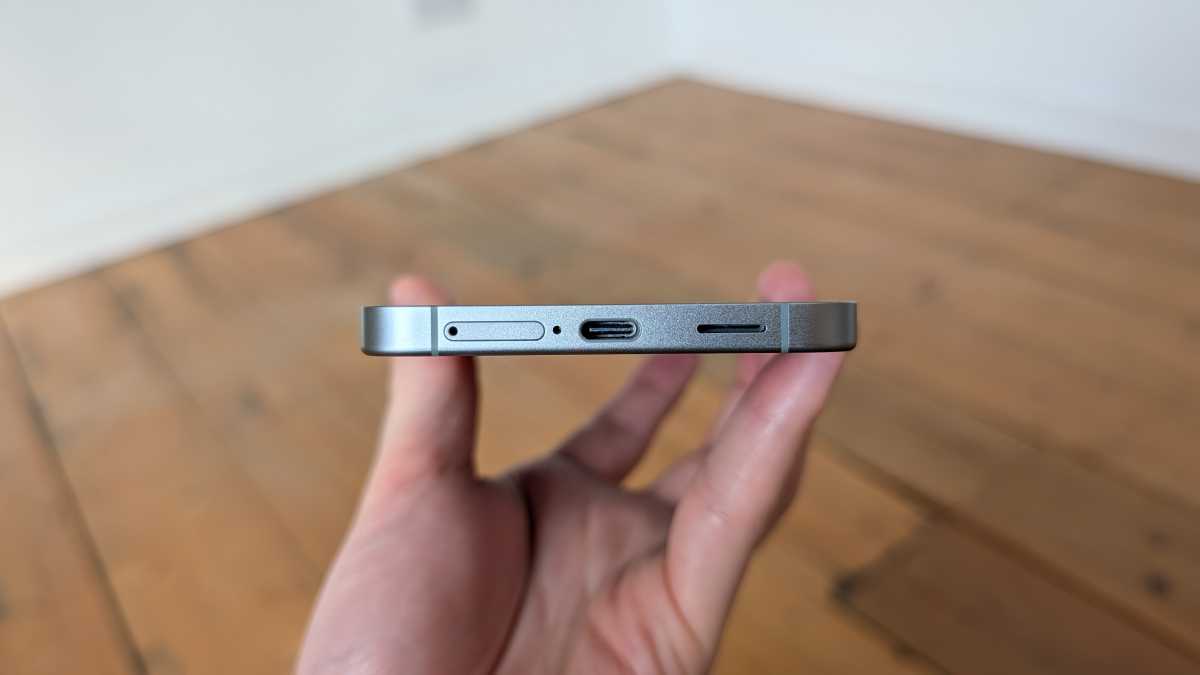
Anyron Copeman / Foundry
But the real question is: do you notice, or even care? I review phones for a living, and these differences are totally inconsequential for me. Unless you plan to throw your phone around with wild abandon or have a custom 7.3mm pocket, I think you’ll feel the same.
All the fundamentals are still here. The S25 FE is an attractive phone, especially in the Navy model I tested, but the Jetblack, Icyblue (a very light blue) and White versions all look great in person.
Build quality is excellent, with a seamless blend of sleek aluminium and tough glass. A matt coating on the back avoids any significant build-up of fingerprint smudges.
The Galaxy S25 FE’s design surprised me in the best way possible
Alongside the rounded corners, it makes the device very comfortable to hold for long periods. As someone who doesn’t always use my phone mindfully (read: doomscrolling), this is significant.
Samsung didn’t provide a case alongside my review sample, which gave me an ideal opportunity to put the S25 FE’s durability to the test.
A combination of my carelessness and the slippery back of the phone meant it fell onto the floor on more occasions than I’d like to admit. However, this isn’t a bad scenario, as I’m trying to simulate longer-term usage in the space of a couple of weeks.
The S25 FE survived those skirmishes unscathed apart from some almost invisible scratches. However, the lack of natural grip means I’d still highly recommend a case – some of Samsung’s official ones add very little bulk.
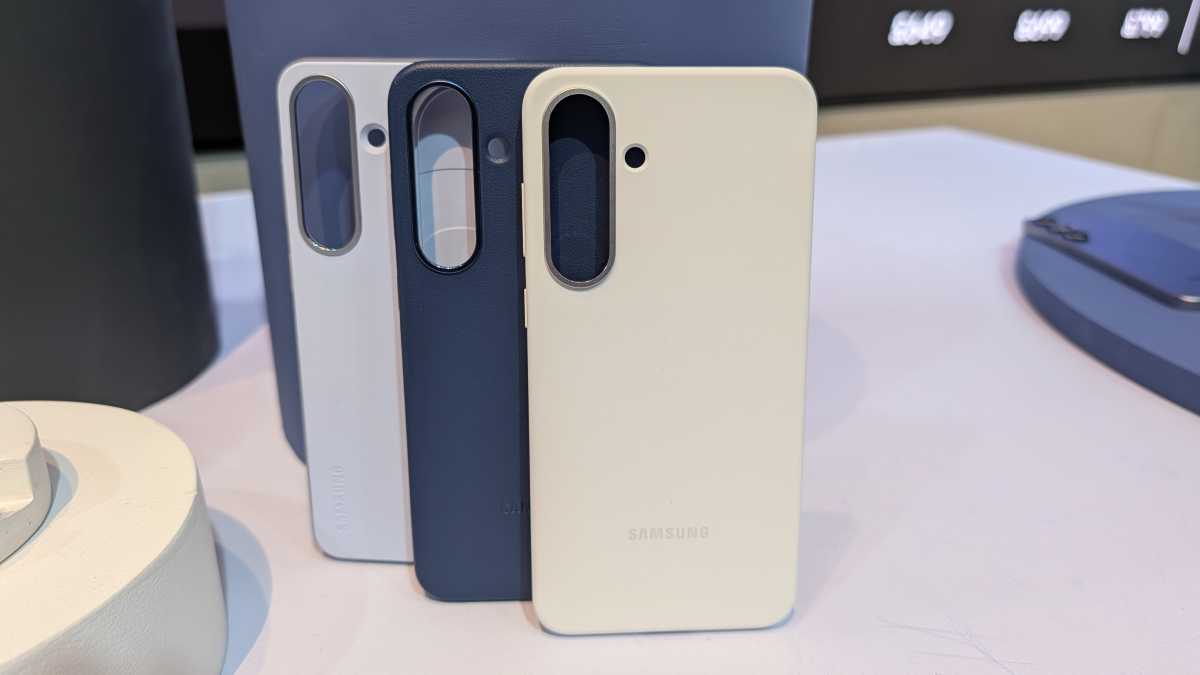
Anyron Copeman / Foundry
Another key selling point is the flagship-level IP68 dust and water resistance, which protects it against dust and submersion in up to 1.5m of freshwater for up to 30 minutes. It’s now common at this price point, but nice to see, nonetheless.
And, despite being a relatively big phone, the S25 FE weighs just 190g – the same as the S25+. Having switched from the 232g Pixel 10 Pro XL, it’s been a refreshing change.
Screen & Speakers
- 6.7-inch, AMOLED screen
- Adaptive 120Hz refresh rate
- Stereo speakers
The Galaxy S25 FE is equipped with a 6.7-inch, Full HD+ AMOLED display, and it’s a real joy to use.
The screen is crisp, vivid and vibrant, delivering the rich colours and deep blacks we’ve come to associate with Samsung’s OLED screens. The resolution is a touch lower than the 1440p S25+, but that device is set to 1080p by default, and I can’t tell the difference unless I really look for it anyway.
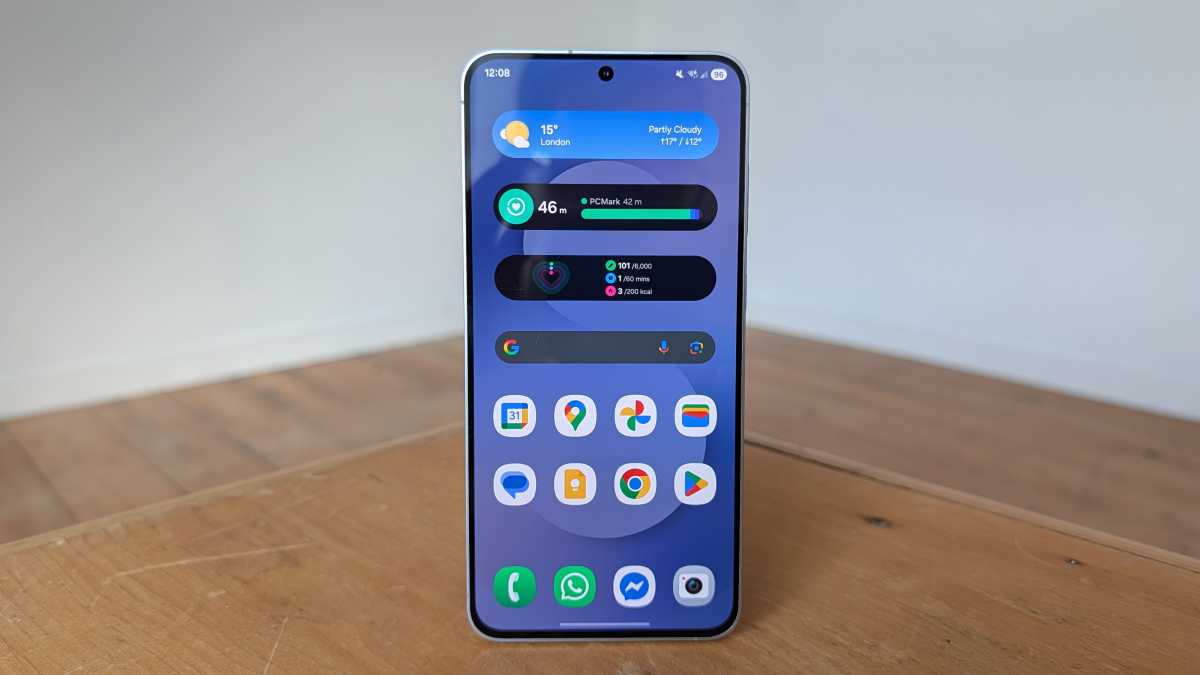
Anyron Copeman / Foundry
The display has a dynamic refresh rate option, which can go up to 120Hz for silky-smooth visuals. LTPO tech means it can automatically drop as low as 1Hz to help preserve power when not required.
I love having this option on phones, as it removes the dilemma between smoothness and battery life. You can have both and it’s rare to see on a mid-range phone! However, the standard 60Hz mode is still there if you want it.
The screen is crisp, vivid and vibrant, delivering the rich colours and deep blacks we’ve come to associate with Samsung’s OLED screens
One area where the S25 FE’s display doesn’t excel is brightness. Samsung’s peak brightness claim of 1900 nits isn’t particularly impressive, while the 422 nits I recorded at home with a professional colorimeter is lower than most phones we’ve tested recently.
However, I used the phone outside on bright sunny days a few times, and it really didn’t matter. Unless the sun is directly shining on the screen, visibility isn’t an issue.
Within the display is a fingerprint scanner, though this is an optical sensor as opposed to the more advanced ultrasonic ones found on Galaxy S25 flagships. It works well most of the time, but seems a touch slower and more sensitive to moisture than the best I’ve tried.
The S25 FE’s stereo speakers are a pleasant surprise. Samsung has opted for the standard combination of downward-firing speaker and earpiece, but the sound is impressively rich and full-bodied.

Anyron Copeman / Foundry
As a result, I rarely relied on headphones when playing audio at home, even when playing longer YouTube videos. However, for serious listening sessions or anytime in public, I’d highly recommend a good pair of headphones or earbuds. As you increase the volume, the lack of bass becomes much more apparent and distortion starts to kick in.
Specs & Performance
- Exynos 2400 and 8GB of RAM
- Strong everyday performance, weaker for gaming
- 128-, 256- or 512GB of non-expandable storage
Under the hood, the Galaxy S25 FE is powered by Samsung’s own Exynos 2400 chipset. On paper, this is very disappointing – not only is it not using Qualcomm’s superior Snapdragon line, but it’s also not even the latest Exynos 2500.
So, I was very much ready to be underwhelmed by the S25 FE’s performance, but that moment never came. If your everyday usage looks anything like mine, with lots of web browsing, YouTube videos, messaging, navigation, emails and the occasional photo, the S25 FE is plenty powerful enough to handle it all.
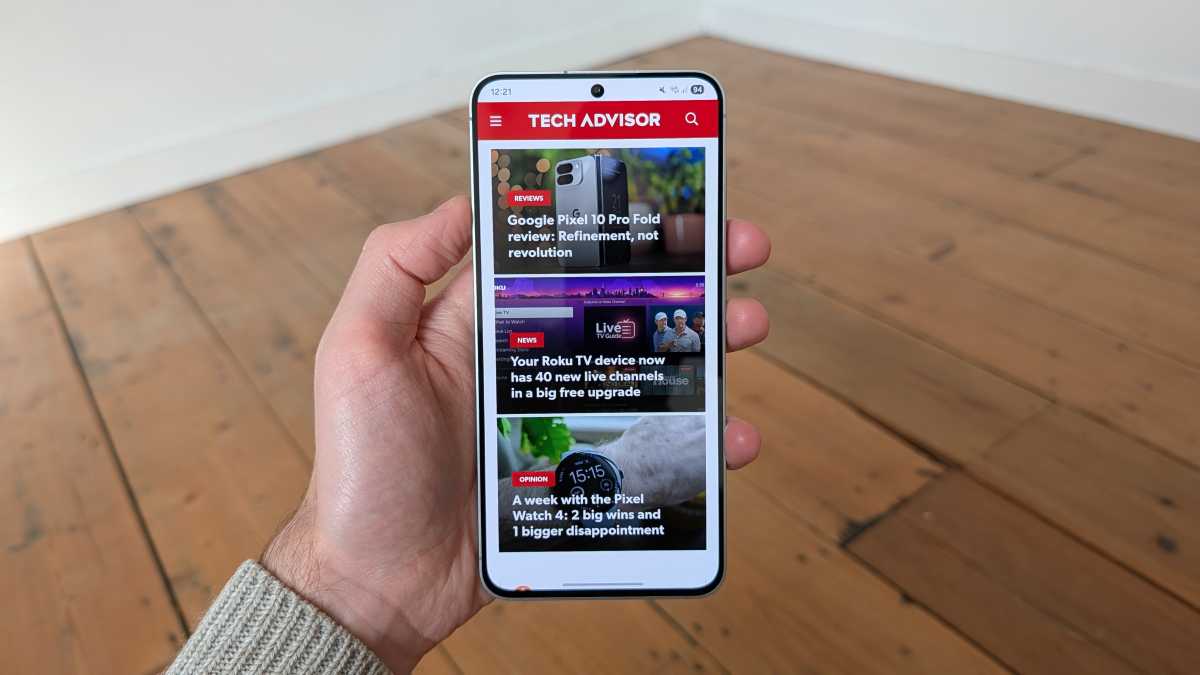
Anyron Copeman / Foundry
Multitasking is also generally strong, with the phone able to run multiple apps simultaneously or two side-by-side without issue. I occasionally ran into issues such as an app crash or temporary screen freeze, but these seemed to be software bugs rather than a performance limitation.
The S25 FE is also adept at casual gaming, but I’d caution against it for long sessions of the most demanding mobile games. That’s when you’ll notice the limitations of the chipset and just 8GB of RAM, with some noticeable stutters and a device that becomes uncomfortably hot to the touch.
I was very much ready to be underwhelmed by the S25 FE’s performance, but that moment never came
If the likes of Genshin Impact, Call of Duty: Mobile or Real Racing 3 are a regular part of your phone experience, I’d encourage you to look elsewhere. But for almost everyone else, the S25 FE offers all the performance you could ask for – it’s certainly plenty for me.
However, it’s worth noting that the entry model of the S25 FE only has 128GB of storage. With no support for Micro-SD card expansion, you might want to step up to 256GB, which is only slightly more expensive. 512GB and 1TB options are also available.
While the phone misses out on Wi-Fi 7, that’s unlikely to affect most buyers anytime soon. The likes of Bluetooth 5.4, NFC and, of course, 5G, are all here.
Samsung Galaxy S25 FE benchmarks
As you can see, the S25 FE falls behind many Snapdragon-powered phones, but it really doesn’t matter.
Cameras
- 50Mp main camera – identical to S25+
- 8Mp 3x telephoto, 12Mp ultrawide
- 12Mp selfie lens
The camera system on the Galaxy S25 FE is downgraded compared to S25 flagships, but not by as much as you might think.
Its 50Mp, f/1.8 main lens is ever so slightly smaller, but otherwise identical. And I can’t tell the difference in image quality, which reflects very well on this cheaper phone.
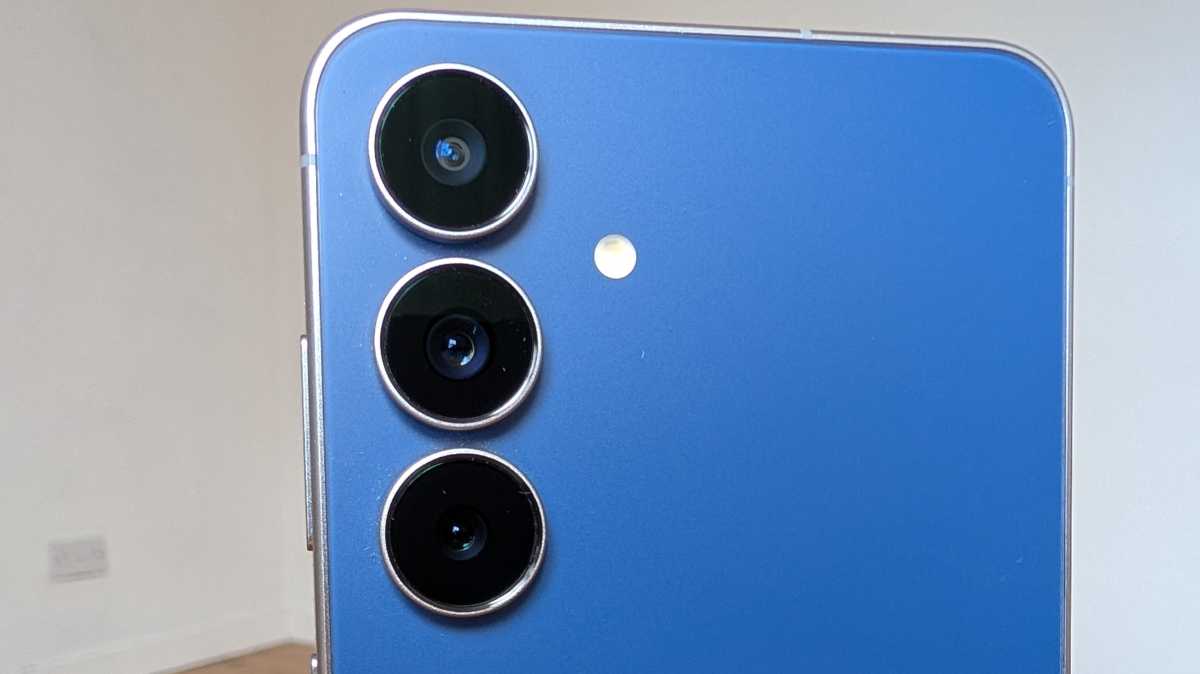
Anyron Copeman / Foundry
Everything I said in my Galaxy S25+ review still applies here. In good lighting conditions, photos are excellent, with crisp detail, strong dynamic range and accurate depiction of shadows.
Samsung has dialled back its high-contrast software processing in recent years, meaning photos are truer to life than ever before. Colours still pop a little more than real life, but the effect is subtle.
Even on a grey autumn day, I could rely on the S25 FE to take a great photo most of the time. However, it occasionally struggled with exposure, especially when trying to capture both dark shadows and bright skies.
In low-light conditions, the long-exposure Night shot mode automatically turns on (though you can disable it). It’s pretty effective at brightening the image without making it look artificial or introducing too much noise, though the Pixel’s Night Sight is still slightly better in my opinion.
By default, the main lens is also used for portrait-style photos. Like usual, my mum’s dog was the most willing model (or he didn’t object, at least), and I was able to get some gorgeous images of him.
When the edge detection was just right, the portrait photos looked impressively professional, despite being very much taken by an amateur photographer (me). However, it was quite hit-and-miss – a great portrait required a few attempts.
Overall, the camera system on the Galaxy S25 FE is solid yet unspectacular
Samsung offers the option to stand further back for portrait photos and rely on the 8Mp, f/2.4 telephoto lens. This is a small downgrade compared to the S25 and S25+, and a big step down from the main lens.
The 3x optical zoom is such a nice option to have, but the overall image quality isn’t always on par. You can go up to 30x digital zoom, but as usual, quality quickly declines once you go past 5x. Samsung doesn’t include any AI tricks like the Pixel 10 Pro’s 100x Super Res Zoom here, though I’m not sure you’re missing out on much.
Elsewhere, I enjoyed the flexibility of the 12Mp, f/2.2 ultrawide, which actually offers a slightly wider 123-degree field of view than the S25 and S25+. I don’t want to compare to these phones too often, but the quality of images from this lens is very similar. Colour accuracy takes a slight hit and some details are lost, but they’re generally usable.
The selfie camera is arguably the best of the lot. It’s only a 12Mp lens, but it consistently offers good clarity and accurate skin tones, day and night. The lens can retain detail in faces and the background simultaneously, or blur the latter via a convincing portrait mode. I’m impressed.
See more samples in the gallery below:
The S25 FE can record 8K video, though I’d recommend the 1080p default to avoid quickly eating into that storage space. It’s nothing to write home about, but it offers enough detail and decent colours to make it a solid choice for home videos or concert footage. OIS (optical image stabilisation) on the main and telephoto lenses do a good job of keeping things relatively steady.
Overall, the camera system on the Galaxy S25 FE is solid yet unspectacular. It has two very good lenses and two slightly underwhelming ones, but it shouldn’t be a dealbreaker unless you want an absolute top-tier camera phone experience.
Software & AI
When I first started using Samsung phones, software was their biggest weakness. TouchWiz (IYKYK) was a cluttered mess that was full of bloatware and prone to lagging.
Oh, how times have changed. One UI 8, which the Galaxy S25 FE runs at launch, is a sleek, modern user interface that’s fast and full of customisation options.
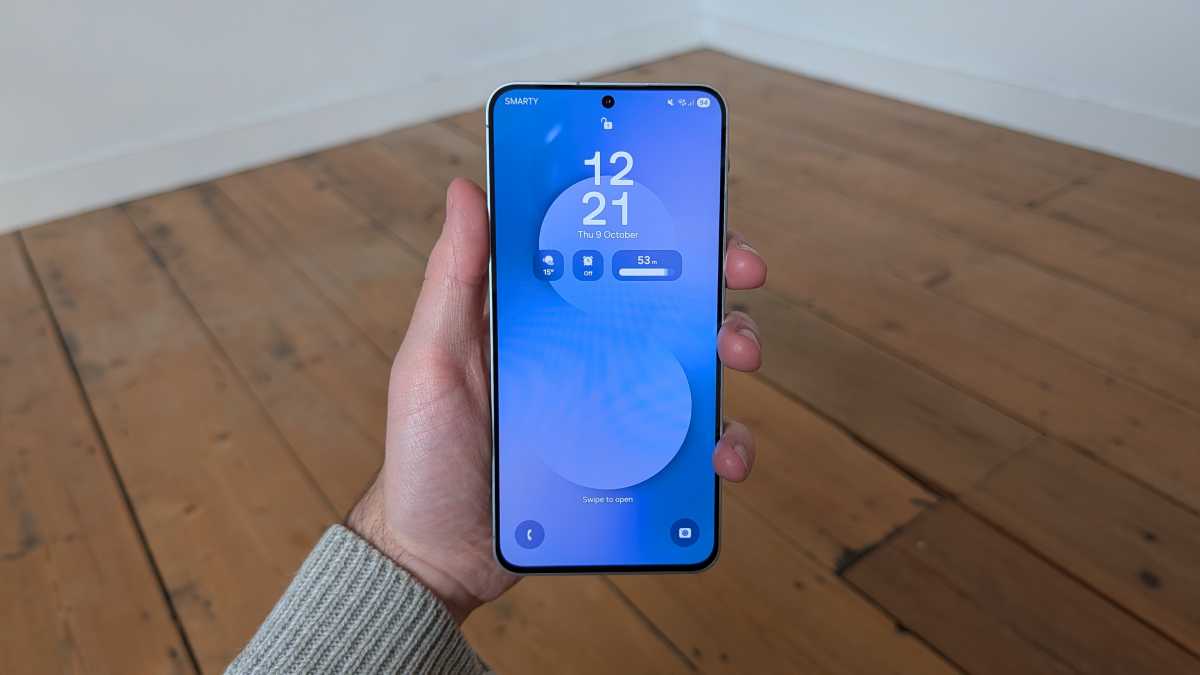
Anyron Copeman / Foundry
It’s based on Android 16, but the experience here is very different to what you’ll find on Google Pixel phones. Do I prefer it? My opinion changes almost monthly, but I think I do right now.
Compared to the Pixel’s stock interface, the biggest upgrade I notice is the design. If you spend a little time customising it, One UI 8 can look stunning without sacrificing functionality.
Unlike Google, Samsung offers full control over the home screen experience, with a range of gorgeous first-party widgets and the ability to remove app labels. As someone who likes a clean design, I can’t tell you how important the latter is to me.
As a complete package, I don’t think phone software gets better than One UI 8 right now
I was initially sceptical of the iOS-style split between notifications and quick settings, but Samsung has implemented it very effectively.
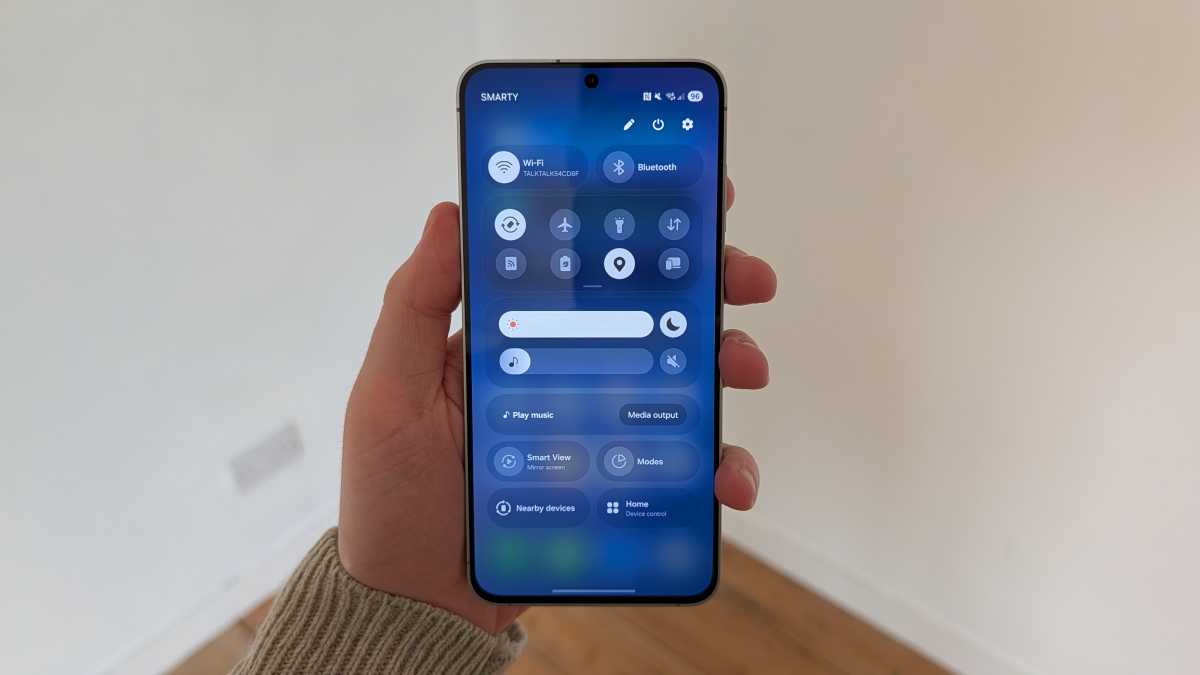
Anyron Copeman / Foundry
Within the main Settings menu, a powerful search function lets you find everything using natural language, which is a game-changer. I wouldn’t have a clue that screen refresh rate is known as ‘Motion smoothness’, but I don’t need to.
Bloatware remains the main weakness of One UI, with Samsung making its own version of almost every Google stock app and pre-installing plenty more from Microsoft for the dollar. However, these can easily be uninstalled or disabled to return the app drawer to a clean and actually useful list.
In terms of artificial intelligence, the S25 FE has the exact same suite of Galaxy AI features as the Galaxy S25 flagships. That includes a range of writing, transcription, summary and editing tools, plus real-time translation for calls and in-person conversations.
You can also generate brand new images or bring your handwritten sketches to life. Having tested these extensively in the past, they can be fun, useful, or both, but I don’t find myself turning to them on a regular basis.
The AI tools that have become a regular part of my life are made by Google. Gemini is the best virtual assistant on any phone right now (Bixby who?), and it solves everyday problems for me on a regular basis. Meanwhile, Circle to Search makes it easy to find anything interesting that pops up on my screen.
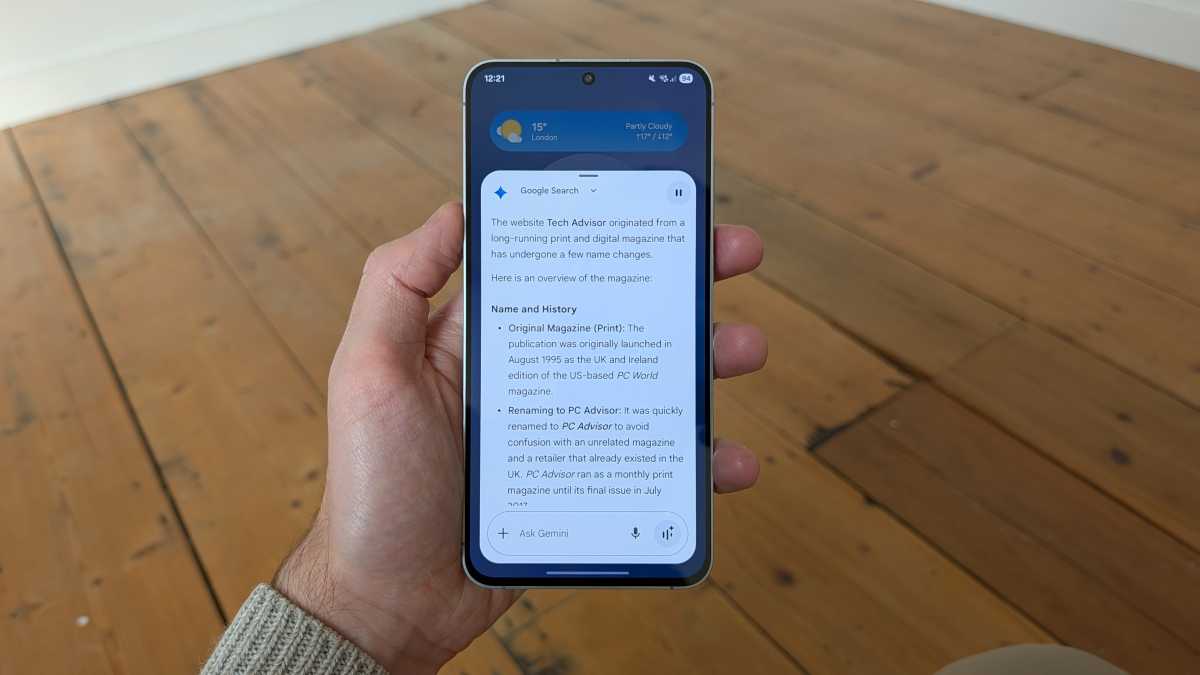
Anyron Copeman / Foundry
As a complete package, I don’t think phone software gets better than One UI 8 right now.
And the seven years of OS and security updates only make it more appealing, though that doesn’t mean they’ll always be prompt. As the One UI 7 rollout showed, the older your device gets, the less likely you are to get a new major version anywhere close to its original release date.
Battery Life & Charging
- 4900mAh battery
- 45W wired charging
- 15W wireless, but Qi2 requires case
I’m very pleased to see that Samsung hasn’t downgraded the battery capacity or charging on the Galaxy S25 FE. Its 4900mAh cell and 45W wired speeds are identical to the S25+, which is great news for a much more affordable phone.
Battery life benefits significantly as a result. As someone who works from home, I can regularly go two days between charges, even with around three hours of use per day.
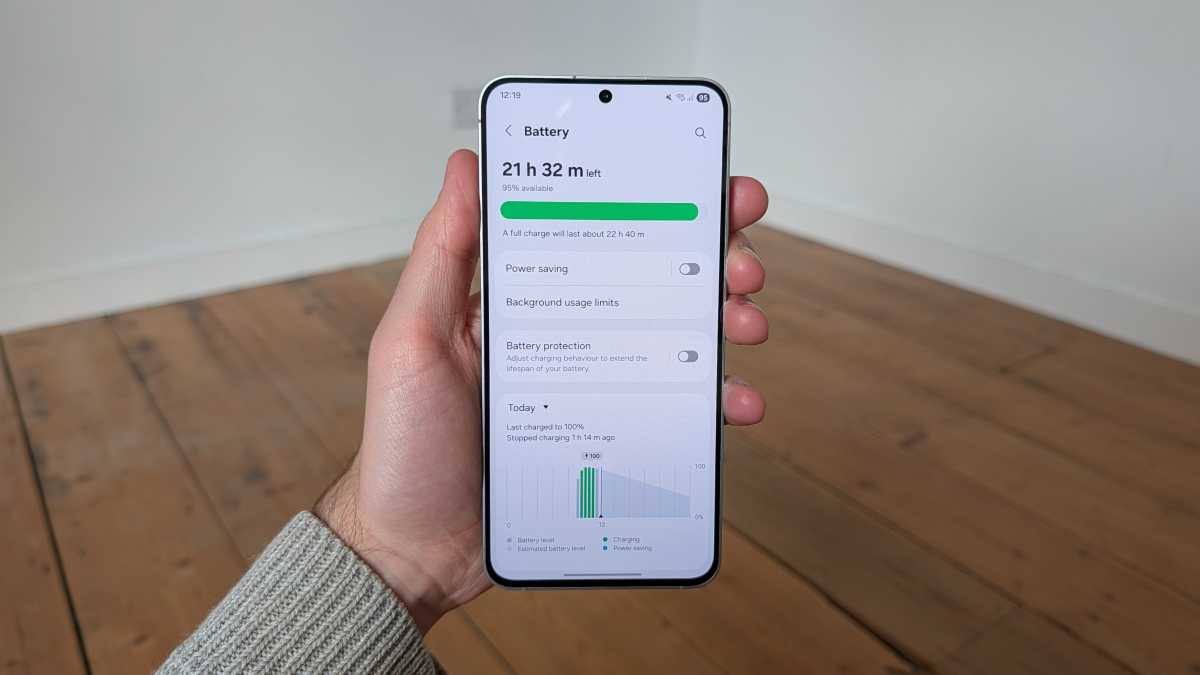
Anyron Copeman / Foundry
On the days when I’ve been out and about, I never once had to worry about whether it might last until the end of the day.
On a recent trip to London, I fully charged my phone in the morning and proceeded to use it for over two and a half hours, including with high brightness, Google Maps navigation and near-constant mobile data. By the time I got home 13 hours later, I still had over 50% charge left. Now that’s impressive.
Unfortunately, our usual PCMark battery test didn’t run on the S25 FE, so I can’t offer side-by-side comparisons. But based on my impressions, battery life is well above average, and a key strength of the S25 FE.
I wouldn’t say the same for charging speeds, but they don’t disappoint, either. Samsung doesn’t include the necessary 45W wired charger in the box, but I now have one which can hit those speeds.
Battery life is well above average, and a key strength of the S25 FE
Hitting 31% after 15 minutes and 63% after half an hour is faster than I’ve come to expect from mid-range Samsung phones, and you might not need much more to get it to last a day. A full charge took me around 75 minutes, which is still respectful.
The S25 FE offers 15W wireless charging, though Qi2 support relies on you attaching a compatible case, as there are no magnets built into the device like the Pixel 10 range. Samsung may well catch up with this innovation with the Galaxy S26 lineup if you feel it’s worth waiting for (though remember the FE model arrives much later).
Price & Availability
At launch, the Galaxy S25 FE starts at £649/$649.99.
That only gets you 128GB of storage, though stepping up to 256GB only costs £699/$709.99. A 512GB model is £799, but that doesn’t appear to be available in the US.
You can buy one now from various retailers, including Samsung UK, Samsung US, Amazon UK and Amazon US, plus a variety of network providers in both countries.
That starting price means it can still be classed as a mid-range phone, though it is one of the more premium devices in that space.
There are two key rivals in the form of the Xiaomi 15T Pro (from £649, not available in the US) and OnePlus 13R (from £649/$599.99), with the regular Pixel 10 and iPhone 17 (both from £799/$799) significantly more expensive.
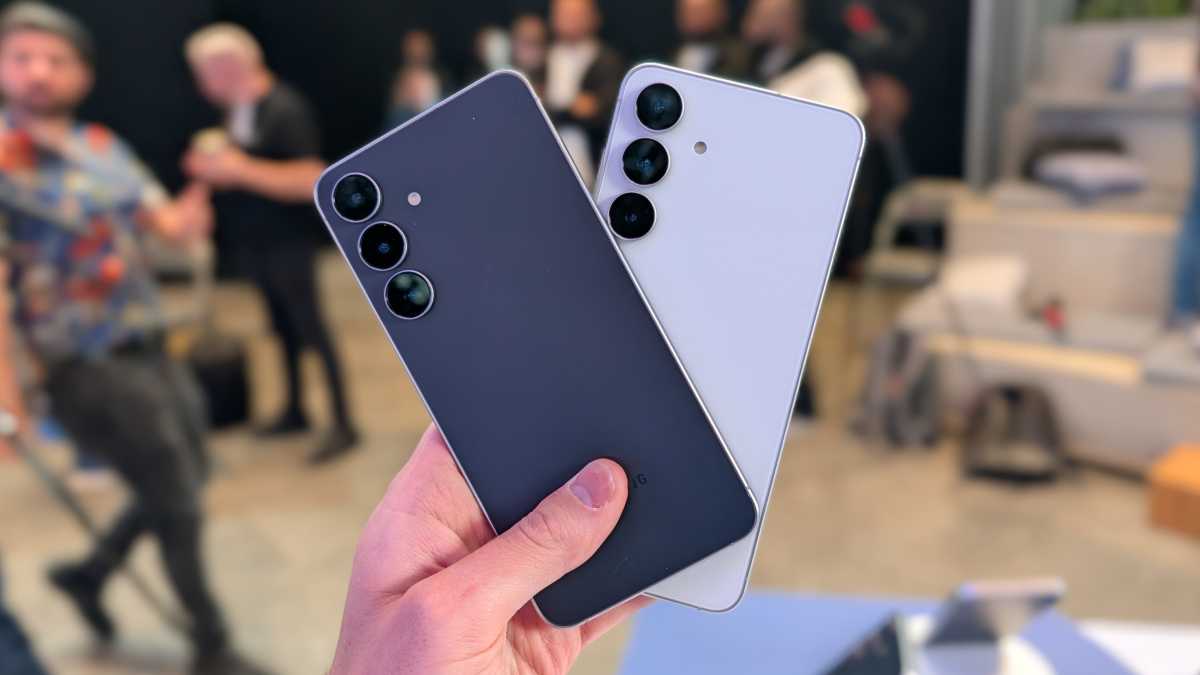
Anyron Copeman / Foundry
Should you buy the Samsung Galaxy S25 FE?
If you’re looking for a great all-round smartphone that significantly undercuts flagships on price, yes. The Galaxy S25 FE is the best outright mid-range phone you can buy, and has enough in common with the S25+ to be a great value choice.
The only real compromises to be aware of are underwhelming gaming performance and hit-and-miss supporting cameras, though the latter also affects the S25+.
The S25 FE is a very well-rounded phone, which I’d be very happy to use as my main device long-term, which isn’t something I often say. If you’re content with its relatively small list of compromises, it’s easy to recommend.
Specs
- One UI 8, based on Android 16
- 6.7-inch, 1440 x 3120, AMOLED, 120Hz
- Optical fingerprint scanner
- Samsung Exynos 2400 chipset
- 8GB RAM
- 128GB / 256GB / 512GB storage
- 50Mp, f/1.8 main camera
- 12Mp, f/2.2 ultrawide
- 8Mp, f/2.4 3x telephoto
- 12Mp, f/2.2 selfie
- Up to 8K @ 30fps rear video
- Stereo speakers
- Dual-SIM + eSIM
- Wi-Fi 6E
- Bluetooth 5.4
- 4900mAh battery
- 45W wired charging
- 15W wireless charging
- 161.3 x 76.6 x 7.4 mm
- IP68 certified
- 190g
- Colours: Icyblue, Jetback, Navy, White















